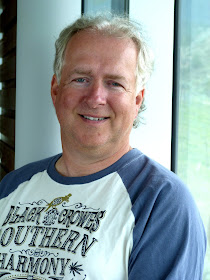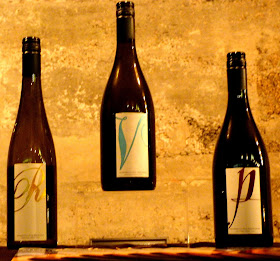Chayee Bourras owners Katrina O'Reilly-Ryan and Gordon Ryan at home in Mill Bay
Gordon Ryan believes that the next popular star in red wines
from Argentina,
where Malbec dominates now, will be wines from a grape called Bonarda.
In fact, Gordon is so convinced that he and Katrina
O'Reilly-Ryan, his wife, have invested in an Argentine winery called Bodega Chayee
Bourras and they are working on that winery’s Bonarda wines in the Canadian
market soon.
The Ryans, who now live in Mill
Bay on Vancouver
Island, tell a remarkable story about the development of their
love of Bonarda.
Both were born in Newfoundland
in the mid-1960s. Gordon, who is the youngest of 14 children, has had a long
career in the oil industry and now runs his own consulting firm from Mill Bay.
Katrina is an employment counsellor.
“My background is petroleum engineering,” Gordon says. “I
started out about 20 years ago working in a refinery in Newfoundland and spent seven or eight years
there until I started to look for a change.”
Gordon grew up a beer drinker. The first of his wine epiphanies
came when he was best man at a wedding for a friend of Italian heritage. The
Valpolicella flowed freely and the flavours were a revelation to his palate.
The second epiphany came in 1999 when the couple took a
sabbatical to Australia and New Zealand,
volunteering as vineyard workers in McLaren Vale in return for room and board.
After doing the harvest in Australia,
Gordon decided that he wanted a vineyard. “That’s where the wine ideas came,”
Gordon says. “We tasted some good red wines down there.”
“We worked on a couple of vineyards,” Katrina recalls. “It
was in your face, right from the growing to harvesting to watching the wine
being made.”
On returning to Canada,
they made a Vancouver Island stopover,
intending to stay two weeks. That lasted three years, with Gordon working a
year at Cherry Point winery near Duncan
to get some vineyard experience.
They thought about going to New Zealand and getting involved in
a vineyard there. The reality, however, was that this was going to need money.
They headed back to Newfoundland
and lucrative work in the oil industry.
They returned to Vancouver Island
in 2005 with the thought of finding a vineyard. At the same time, Gordon
partnered with colleagues to establish his own oil and gas consulting business
and that generated the cash flow to keep him hunting for his own vineyard.
Initially, they looked on Vancouver Island.
They tried to buy Blue Grouse Estate Winery but could not agree on terms.
The hunt turned to Argentina in 2007. “My favourite
wine is a good full-bodied red,” Gordon says. Plenty of those were coming from Argentina, so
he began looking there. His timing was right. Argentina has just coming through
one of its periodic financial crises in which the peso has been devalued.
Vineyards and wineries were a comparative bargain.
After several years of looking, Gordon found a vineyard in
the Cuadro Benegas district near the city of San Rafael,
about two hours south of Mendoza,
Argentina’s
wine capital. The vineyard owner, Carlos Gomez Bourras, had run short of funds
while building Bodega Chayee Bourras.
“Our idea was to buy a vineyard and, if we want to produce
wine later, we would build a winery,” Gordon says. “It just so happened we came
upon a guy who was looking for a partner. He had to sell his land to finish his
winery.” The winery was completed after Gordon purchased the 50-acre vineyard
(half of it planted) in 2009. With
another Canadian, Craig Gamble, Gordon is just taking a 40% interest in the
boutique winery which was completed in 2010.
“We were able to make the wine in partnership with him,”
Gordon says, noting the owner’s son, José, is a winemaker. The winery also
employs an experienced consulting winemaker.
Much of Gordon’s vineyard consisted of 40-plus year old
Bonarda vines. “We ended up with one of the best Bonarda vineyards in Argentina,” he
believes. “The Malbec is what I thought I would be producing but we happened on
the Bonarda. It is going to be the next niche wine from this area.”
Depending on the source one goes t0, Bonarda is an old
French or Italian varietal. The cuttings likely were brought to Argentina by
one of the early waves of Italian immigrants. The variety thrived to become the
most widely grown red until this decade, when it was overtaken by Malbec
acreage.
Gordon and Katrina plan to launch the Chayee Bourras wines
in Canada
with an allotment of just 200 cases from the 2011 vintage. Of course, they plan
to have more for sale as the brand gets established. Total production at the
winery in 2011 was 800 cases of the “classico” and about 580 cases of the
“reserve.”
“That’s what the plan is for three years,” Gordon says of
the winery, which still sells most of its grapes. “We will ramp it up when we
get it established.” He also plans to make a Malbec.
The two Bonarda wines they are offering illustrate the
versatility of the variety to make both an easy-going quaffer and a big,
cerebral red.
Chayee Bourras
Bonarda Classico 2011 (estimated price $23 - $25) is aged entirely in
stainless steel with oak immersed in the wine. It is a delicious wine, with
aromas and flavours of a potpourri of red fruits (blackberry, raspberry,
cherry), placing sweet fruit flavours on the palate. However, the wine, with
soft tannins, has a dry finish, with persistent fruit flavours. 90.
Chayee Bourras
Bonarda Reserva 2011 (estimated price $45) benefits from more winemaking
tricks, starting with longer hand time and maceration after fermentation (30
days) as well as before. That extracts more flavour and a richer tannin
structure. The wine also is aged six months in oak – 70% French barrels, 30%
American barrels. The result is a rich and full-bodied with dramatic aromas of
black cherry, vanilla, spice and coffee. On the palate, there are flavours of
plum, black cherry and coffee. 91.
The Ryans are not the only Canadian investors in Argentina. In
March, Ann Sperling and Peter Gamble released (in Ontario) a $60 Old Vine Malbec under the
Versado label. Ann and Peter are leading consulting winemakers in Canada who also own a vineyard and guest house near
Mendoza.
The couples know each other. On his first trip to Argentina,
Gordon stumbled on the guest house. Subsequently, the Ryans have stayed there.
“I have kept in touch with them,” Gordon says, who bought a
bottle of Sperling Vineyards sparkling wine this summer as a gift for his
Canadian staff.
























